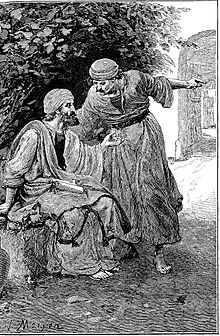Philip

Philip (* in Bethsaida , Galilee ; † probably around 81 in Scythia in today's Ukraine ) is one of the twelve apostles of Jesus (Matthew 10: 3). He is to be distinguished from the deacon Philip mentioned in the Acts of the Apostles (Acts 6.5) , even if the two biographies of Philip were mistakenly linked in the legend.
Bible

The three synoptic evangelists only mention Philip in their lists of the apostles.
| Book in the Bible | Introductory words | Mention of Philip |
|---|---|---|
| Gospel of Matthew | " The names of the twelve apostles are: [...] " | Mt 10.3 EU |
| Gospel of Mark | " The twelve he used were: [...] " | Mk 3.18 EU |
| Gospel of Luke | “ When day came, he called his disciples and selected twelve from among them; he also called them apostles: [...] " | Lk 6.14 EU |
| Acts of the Apostles | " When they got into the city, they went up to the upper room, where they stayed now [...] " | Acts 1.13 EU |
The Evangelist John, on the other hand, gives various details about Philip:
- Immediately after his own calling, Philip brings another man, Nathanael , to Jesus ( Jn 1,43–51 EU ).
- Philip is put to the test by Jesus on the occasion of the miracle of the multiplication of the bread , but cannot imagine a miracle ( Jn 6 : 5–7 EU ).
- For Greeks who want access to Jesus, Philip, who also has a Greek name, acts as a middleman ( Jn 12 : 20–22 EU ).
- In Jesus' farewell speeches, Philip does not understand how God can be known and asks Jesus to show him to the disciples ( Jn 14: 7-11 EU ).
Philip is described by John as a disciple who does not understand everything and still brings people to faith.
Further tradition
The news about his later life is confused and uncertain. Perhaps he worked with Andreas in the Black Sea areas, perhaps in Hierapolis (Asia Minor). Nothing is historically certain about his end, but he probably died a martyr's death in Scythia in the Ukraine.
The Italian archaeologist Francesco D'Andria from the Università degli studi di Lecce claims to have discovered the tomb of Philip with inscriptions in the ancient city of Hierapolis , today's Pamukkale in the western Turkish province of Denizli , where he and two of his daughters according to the report of Eusebius of Caesarea (Historia ecclesiastica III 31, 2-3; V 24, 2-3), who refers to Bishop Polycrates of Ephesus , is said to have died.
iconography
From the 12th century on, Philip is depicted with a book or a scroll. An example of this is the three kings shrine in Cologne Cathedral from 1185 . Beginning in the 14th century, the Latin † cross ( crux immissa ) or the Greek T-cross ( crux commissa ) were added, such as in the relief from 1340 in Lübeck Cathedral or the stone sculpture designed in 1480 in the Tübingen collegiate church .
Remembrance day
- Roman Catholic:
- May 3rd ( Feast in the General Roman Calendar , shared with James )
- in Russia: November 14th
- Old Catholic : May 1st (together with James )
- Evangelical (together with James, the son of Alphaeus ):
- Evangelical Church in Germany : May 3rd (memorial day according to the Evangelical Worship Book)
- Evangelical Lutheran Church in America and Lutheran Church-Missouri Synod : May 1st
- Anglican : May 1st
- Orthodox: November 14th
- Transfer of the bones to Cyprus: July 31st
- Coptic Church: November 18th
- Armenian Church: November 17th
literature
- Christopher R. Matthews: Philip: Apostle and Evangelist. Configurations of a Tradition , Supplements to Novum Testamentum 105, Brill, Leiden u. a. 2002, ISBN 90-04-12054-8
- Gregor Martin Lechner : Philip . In: Lexikon der Christian Ikonographie , Vol. 8. Herder, Freiburg 1976, Sp. 198–205
- Alfons Weiser : Philip . In: Lexicon of Saints and Adoration of Saints, Vol. 2. Herder, Freiburg u. a. 2003, col. 1313-1315
- Wolfgang Weiß: PHILIPPUS, Apostle. In: Biographisch-Bibliographisches Kirchenlexikon (BBKL). Volume 7, Bautz, Herzberg 1994, ISBN 3-88309-048-4 , Sp. 503-507.
Web links
See also
- New Testament
- Gospel of Philip
- Philip (Deacon)
- Philip Church
- Philip and James Church
- San Filippo
- Philip Lent
Individual evidence
- ↑ Konrad Algermissen , Church History from the Beginnings to the Present (Celle 1955), p. 10
- ^ Presumed grave of Apostle Philip found (Focus online, July 27, 2011
- ↑ See Stanley A. Shepherd: The Stained Glass of AWN Pugin . Spire Books, Reading 2009, ISBN 978-1-904965-20-6 , pp. 418 .
| personal data | |
|---|---|
| SURNAME | Philip |
| BRIEF DESCRIPTION | apostle |
| DATE OF BIRTH | 1st century |
| PLACE OF BIRTH | Bethsaida , Galilee |
| DATE OF DEATH | at 81 |
| Place of death | Scythia |
